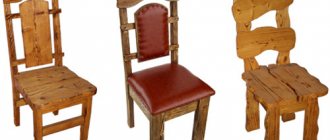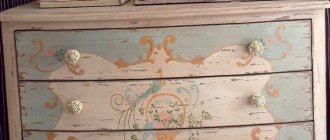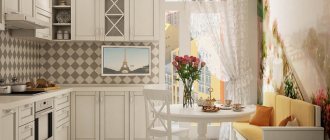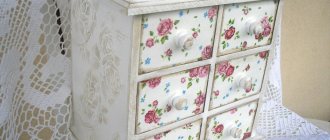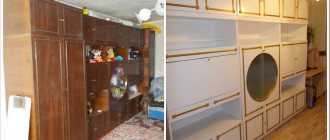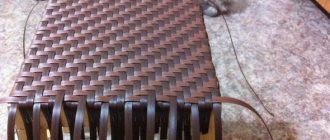What is Provence? This is stylish negligence, wear and tear, a touch of antiquity remaining on things, the use of natural materials and elegant simplicity of forms combined with romantic, unpretentious decor. They say that furnishing your apartment in accordance with the requirements of this popular design movement will give your home the atmosphere of a country home located in the south of France. Tempting, and most importantly unusual. I like this style for its simplicity and discreet charm. In this article, I'll show you how distressed wood furniture can transform a space and become a magnet for guests with good taste.
A guest from another century or an ode to Provence
Yes, these are the same chairs and chests of drawers, sofas and stools that can become full-fledged parts of a stylish interior. Who said that old means ugly? Or that everything that is peeling and cracked belongs in the trash? I assure you, people deliberately cover new furniture with a layer of patina, causing chips and cracks, so that it passes for antique.
So, we want the room to be different from many others, and let’s do it - it’s never too late to change the design of the living room or kitchen and fill the room with artificially aged furniture, as in the photo on the Internet.
What you need
- Electric drill. Who knows where and what holes will need to be drilled, and it’s more convenient to screw in screws not by hand.
- Hammer. Naturally, to drive nails or dowels.
- Roulette. Without accurate measurements - nowhere.
- Level.
- Carpenter's pencil. It is easier to mark directly on the workpieces.
- Glue.
- Hacksaw for processing wooden workpieces.
- A large number of screws.
The first step is to evaluate the quality of all the details of our future design. We make sure that there are no cracks, swelling, or chips. The surface of all elements must be perfect. We transport individual items in compliance with safety regulations. All parts must be securely secured in the vehicle. Before starting work, you need to prepare a drawing of the future cabinet, and at the same time select its future location. In this process, we need to build on personal preferences and the space we have. Most often, cabinets are located in pantries, in the corners of rooms or near walls.
What should be the interior details in Provence style?
- Current accents in your living room or bedroom - varnished chests of drawers, paintings on the walls, armchairs and poufs, bedside tables and banquettes, dressing tables - all that is undeservedly forgotten by admirers of the high-tech style. Their distinctive feature is pastel colors, barely noticeable traces of antiquity - patina, cracks, slight wear of surfaces.
— Small-form interior items are dearly loved by fans of French Provence. Take, for example, a banquette - it’s convenient to put things on it, or you can just sit and relax on it. It looks stylish and elegant, does not take up much space. Or a bureau - it is practically not found in modern interiors, but is used with pleasure by lovers of antique furniture. This French table with sliding drawers is the perfect addition to the design project of a room worthy of kings.
- Armchairs, chairs, chests - they all should be wooden. Yes, yes, this style does not tolerate artificiality in materials, although it easily accepts false “antiques”. Tables or sideboards made of oak, walnut or chestnut from FOREST GROUP will come in handy in interiors reminiscent of France - its charm, grace and simplicity.
There will also be opponents to the use of furniture aging techniques. Their arguments are always the same - why spoil new things, it is customary to get rid of what is spoiled, and not put it on display, and so on. Tell this to those who collect antiques - they will happily argue with you.
Your humble servant thinks differently - it seems to me that modern furniture is very functional, but completely identical and faceless. A comfortable environment and cozy atmosphere are created precisely by original details that are pleasant to look at and touch. They carry a special energy, a charge that is transmitted to everyone who comes into contact with them.
How to age furniture made of chipboard or wood with your own hands without attending master classes? Read on - I will be your guide in the world of transformations in the Provence style.
We are exploring other styles for decorating furniture
Using the master classes described above, you can give old and boring chairs a wonderful Vintage, Provence or Viennese style. In the meantime, look at the beautiful photos:
The new table turns... into an antique
Either a stool, or a chair, or a banquette - whatever comes to hand, we will transform. I advise you to be patient and... paint. It should be of different shades. Gray is required - to mute bright colors, and also a base tone - baked milk, ivory or neutral white.
By the way, some artificially aged furniture is left whitewashed. Of the special techniques, only patination is used - it is intended to emphasize the “centuries-old” history of the item, even if it was purchased last week. The milky shade is dearly loved by romantic natures - it looks fresh and puts you in the mood for pleasant thoughts.
So, let's get to work.
The second stage - creating a stylish shabby look
Yes, you heard right - this is the artificial aging of furniture with your own hands. Those who in childhood loved to paint with watercolors and use everything they could get their hands on as tools know what intricate patterns were left by the remains of a candle on thick paper. And in front of us is a tree. To create shabby corners we need paraffin. We rub it on those areas that should stand out.
Afterwards you will see how easily the paint will come off from areas treated in this way. But we are just waiting for this.
How to make a locker age
We will need the following materials:
- paint, always light in color;
- sponge;
- sandpaper;
- wax candle;
- varnish
Sequence of work:
- Clean the cabinet from the coating using sandpaper.
- Rub thoroughly with a paraffin candle according to the growth of wood fibers. All this must be done very carefully and carefully, without skipping any sections.
- Paint the coating. You can use aerosol paint, this will make it easier to process the cabinet.
- Then, using a kitchen sponge, start wiping the newly applied substances onto the surface from top to bottom. The main thing is not to overdo it, as excessively erased spaces will not look at all aesthetically pleasing.
- It all depends on the desired result. You can apply a drawing or painting to the surface.
- Secure with varnish.
The third stage - putting putty into action
In the photo of whitewashed or aged furniture in the Provence style, transformed with your own hands, you can see what an interesting texture it has, what an unusual relief. This is why we need putty. We generously cover and fill dents and cracks with it, which only spoil the appearance of the thing, and we also create volume with it. After application, it seems that the table or chair has already been covered with a dozen layers of paint - but no, there are not so many of them.
Don't forget to put gloves on your hands and take out a thick apron - you won't be able to stay clean when working with putty.
The fourth stage - paint, but without fanaticism
We apply the selected tone, but do not forget that someday we will have to stop. Most often, 3-5 approaches are enough. Further there will be only a senseless waste of material.
Combinations of a bright base under rich dark top layers look interesting in the Provence style. It looks unusual - you can be sure that no one else will have such a piece of furniture.
Repainted wood effect
Another method of artificially aging wood in the primitive country style, which uses two coating colors: the main dark one and the contrasting light one. The result is a special effect of an old plane being repainted twice. Despite the apparent simplicity of the technique, there are special secrets to applying a second contrasting color: in order to minimize effort and time when sanding, so that one color extends beyond the edges of the other, the worn surface shines through. If you apply a contrasting tone completely and then wash it off, it will be very difficult not to miss the moment when the main one is erased along with the top one.
Fifth stage – patience and work will grind everything down
We don’t need to grind anything - just achieve light wear, as in the photo of furniture that has undergone artificial aging with our own hands. This is where the base coat of paint comes in handy - it will show through on the treated area.
After drying, take a fine piece of sandpaper (or a large one, depending on the effect we are trying to achieve) and rub the surface until the excess paint comes off and the color itself is half erased.
I’ll add on my own – this is real magic with your own hands. It is difficult to remain indifferent to the process. But if you are afraid of spoiling the thing and grieving afterwards, entrust the production of furniture in an aged style to the professionals from FOREST GROUP.
Thermal method
In this case, the wooden surface is burned with a blowtorch until the knots and texture pattern become clearly visible. This is the first stage of aging. Then carbon deposits are removed from the surface and a more prominent structure is achieved using a metal brush.
To make the wood pattern even more expressive, you can coat the product with one layer of stain and a layer of varnish
This method requires care and precision, since careless use of a blowtorch can irreversibly damage the furniture
You can age furniture thermally using a kerosene burner (instead of a blowtorch). In this case, the surface can be treated with a metal brush both before and after heat treatment. As you work, do not hold the fire in some areas longer than others. It is best to do this work outdoors - in the yard or on the balcony.
Stage six - patination
The word “patina” even sounds noble, and the tables and chests of drawers covered with it look as if they belonged to the French king himself - and have been well preserved from those times.
It is better to choose bronze or gold shades. We apply them with light strokes and little by little, so as not to overdo it. Then we wait. As soon as the paint sets, take a dry rag and rub the treated areas. Then we coat it with varnish.
By the way, which areas are best to choose for patination? I advise you to cover flat surfaces with bronze or gold. It is better not to touch edges and other places that are often subject to mechanical stress (for example, fittings).
You can use bitumen varnish instead of paint. It should be applied with a brush, but not a regular one, but a round one. First, we put the bristles in a jar, then we run it over the paper, rubbing the varnish, and then we work directly with the wood. Movements should be careless, sweeping. The result is an instant creation of a noble texture of old furniture in the Provence style, created with your own hands.
That's all - the unusual piece of furniture is ready. It's nice to look at, it's nice to touch. In short, this is a work of art.
Working on wood products is an interesting and exciting process, but only for those who like to spend their free time armed with paint, putty and varnish. For those who are not ready to devote a day to transforming chairs, tables and banquettes, experts will help - FOREST GROUP will take on the production of antique furniture in the Provence style, so that you do not have to make an antique out of a new thing with your own hands.
Tips from Daria Geiler
- Painting wood “to look like Provence” is easiest and most cost-effective with regular acrylic water-based paint, for example, for ceilings. It does not smell, dries quickly, and can be tinted at home to the desired shade.
- Before working on old surfaces, cover them with primer. You can apply any paint to the primer, or you can reduce the number of layers by tinting it in the desired shade.
- The final coating can be done with varnish; it is better to take a matte one: it will not highlight unevenness, extra drops, etc. like a glossy one.
- As a patina, you can use not only bitumen varnish, but also silver. Kzubasslak is useful for light surfaces, silver for dark ones, on which the varnish will not be visible, and the white patina will be too contrasting.
- To preserve and highlight the color and texture of natural wood, use oil. You can also use varnish or wax as a finishing coat, but often the latter is already contained in the oil.
- If you want to use really old boards at home and you don’t mind what, for example, the pallets went through before they ended up in your home, at least treat the boards with an antiseptic without bleach. You can also buy it at a hardware store. A compromise option is to age the boards yourself: just paint them and stick them into the ground at the dacha. In a year, you will have naturally aged boards with a known fate at your disposal.
And finally, one more useful tip - watch! Observe how things age, how antiques look at flea markets, how old stairs are worn out, how plaster crumbles from bright walls. Get inspired on your way to work, while traveling, and online. After all, even if you learn all the techniques and tricks, only nature can teach you how to create something that will look beautiful and natural.

